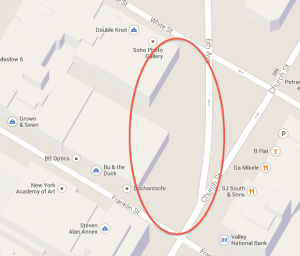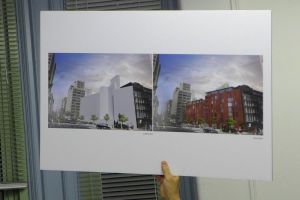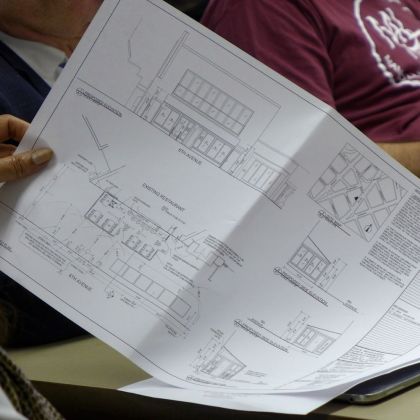Categories
Left column house ads
CB1 Tribeca Committee: The Unofficial Minutes (November 2014)
November 13, 2014 Construction, Events, Real Estate, Restaurant/Bar News
WORTH STREET RECONSTRUCTION PROJECT
Postponed.
 100 FRANKLIN: BOARD OF STANDARDS AND APPEALS VARIANCE
100 FRANKLIN: BOARD OF STANDARDS AND APPEALS VARIANCE
100 Franklin, you may recall, is the funky plot between White and Franklin (currently parking lots) where DDG wants to build two triangular buildings. The Landmarks Preservation Commission approved the design in January, but DDG is seeking variances from the Board of Standards and Appeals, and so Community Board 1 gets to weigh in.
Emotions ran high; voices trembled.
DDG presented on the requested variances and the criteria that it must been for them to be granted, and the neighbors rebutted with logical arguments refuting DDG’s numbers (DDG’s residential comps of $1,400 to $1,800 per square foot produced LOLs), rants against the “cynicism” of the request, and conspiracy theories. “The fix is in!” someone actually yelled.
 I’m a bit hazy on exactly what the variances and criteria are, other than that DDG says the plot is tricky and adapting to it means it needs the variances to make it financially viable. (Hence the LOL comps.) Most of that was irrelevant, at least to last night’s discussion. The neighbors resent this development deeply, and they’re threatening to sue to prevent the variances from being granted—even though DDG can build a taller building as of right (see pic above—that’s a representation of it at left), and it will certainly build something that blocks their lot line windows and air shaft. “It’s all well and good to come here saying you want to protect Tribeca,” observed one committee member drily (I’m paraphrasing), “when I don’t recall seeing any of you come to meetings about other parts of the neighborhood.”
I’m a bit hazy on exactly what the variances and criteria are, other than that DDG says the plot is tricky and adapting to it means it needs the variances to make it financially viable. (Hence the LOL comps.) Most of that was irrelevant, at least to last night’s discussion. The neighbors resent this development deeply, and they’re threatening to sue to prevent the variances from being granted—even though DDG can build a taller building as of right (see pic above—that’s a representation of it at left), and it will certainly build something that blocks their lot line windows and air shaft. “It’s all well and good to come here saying you want to protect Tribeca,” observed one committee member drily (I’m paraphrasing), “when I don’t recall seeing any of you come to meetings about other parts of the neighborhood.”
This is going to be an unpopular observation, but locals already forced DDG to swap out the initial design for a far less attractive one that’s said to be “contextual” because it has bricks. (We’re talking about Sixth Avenue, mind you.) And is it really cynical for a developer to try to squeeze whatever it can from the system? That’s not cynicism; that’s capitalism. (That said, fudging the comps was not a smooth move.)
It was a long, ugly discussion. One CB1 Tribeca Committee member announced he was abstaining because the dispute has injured friendships; his wife even got the silent treatment at the Food Emporium. “I will carry this affront for the rest of my life,” he declared.
The committee was pretty sure it wasn’t the best judge on the merits—the BSA would do that—but it decided that as a representative of the community, it was comfortable deeming the variances unjustifiable. If DDG is claiming financial hardship because of the limitations of the location (the shape, the adjacent subway, etc.), it should’ve have factored that in when it bought the land. Vote to oppose: 8-0-1.
P.S. DDG also said it was talking to the Department of Transportation about (re)designing the peninsular stretch between Sixth and Church (which I think they said is called Barnett Newman Plaza?), adding greenery and other improvements, something that would have to go through the usual public review process. Residents viewed it as a paltry attempt to curry favor.
SIDEWALK CAFÉ PERMIT: 11 SIXTH AVE.
Gregory Nardello, the owner of 11 Sixth Avenue, is opening a restaurant in the two-story building (which is still in a state of reconstruction) where the Brite Buy liquor store used to be. He already got a 4 a.m. liquor license, and now he wants to add an enclosed sidewalk café—i.e., an atrium like the one at Super Linda (or Delphi, if longterm memory is more your style). If I understood correctly, it would extend 10 feet into the sidewalk. The project’s architect, Steve Wygoda, is a public member on the committee, so the committee members hesitated before deciding that it felt like a land grab and anyway they don’t like to approve sidewalk café licenses of any kind without the establishment being open for a year. Vote to oppose: 8-1.
 STREET-ACTIVITY APPLICATION: WASHINGTON MARKET SCHOOL BLOCK PARTY
STREET-ACTIVITY APPLICATION: WASHINGTON MARKET SCHOOL BLOCK PARTY
It’ll be on Duane between Church and W. Broadway on Saturday, May 9. No fundamental changes from previous years (so we’ll have to assume that it’s not ending at 4 a.m., as the agenda indicates). Vote to approve: 9-0.
BEER-AND-WINE LICENSE APPLICATION: NEW SUN CAFÉ (67 READE)
Reps from the Japanese restaurant didn’t show.
LIQUOR LICENSE APPLICATION: GUNBAE (67 MURRAY)
Community Board 1’s full meeting rejected the barbecue restaurant/karaoke bar’s liquor-license application last month, saying it wanted revised plans with more detail and a sound attenuation plan from a certain acoustic engineering firm. The closing hours are now midnight (Sunday through Thursday) and 1 a.m. (Friday and Saturday), and there are only four karaoke rooms downstairs. Much time was spent going over the floor plans to determine whether they meet ADA requirements—i.e., wasting everyone’s time by doing the work of the Department of Buildings. When the chair decided it was time to move on, a member of the committee asked for details of the submitted sound attenuation plan, and the chair insisted it proceed directly to a vote. The committee member objected, and was told, “I’M THE CHAIR AND YOU’RE NOT!” A resident of the building, upon exiting, said she, too, would have liked to hear the details, to no avail. Vote to approve: 6-0-2.
LIQUOR-LICENSE RENEWAL: CHURCH STREET TAVERN (313 CHURCH)
It had confused me from the start how Church Street Tavern didn’t have to get its liquor license initially approved, but the folks on hand (including the owner of Stuzzicheria, who said he’s the manager of Church Street Tavern) said that the same corporation that owned Tribeca Canvas (and presumably Bisutoro) owns Church Street Tavern. (“You’ve been operating two years?” asked the chair, to which they nodded. They must have heard “months” instead of “years.”) So now that that the 4 a.m. liquor license is up for renewal, the committee called the restaurant in to talk about residents’ complaints. The issues involve the downstairs club, Bandits Roost. Instead of using the stairs inside the upstairs dining room, patrons have accessed it via the residents’ entrance—and residents have had to explain to the bouncer who they are. The restaurant’s reps said that they’d prefer the owner to divide the entranceway into two, as at Macao Trading Co. next door, but since one of the residents is a woodworker who needs to move big pieces in and out, they used a metal security gate to divide it instead. The committee thought it sounded like no way to live. (Did I mention the building is rent-stabilized, perhaps fueling the building owner’s lack of concern?)
Residents and neighbors also say the music has been unbearable. There were questions about whether the method of operation is now substantially different from what Tribeca Canvas applied for, and concerns that the State Liquor Authority won’t care if there isn’t a record of problems (i.e., logged 311 calls). Eventually, the owner—who had let the manager do most of the talking—said he’d be fine with no longer using the residential entrance at all, hire a sound engineer to see what can be done about the thumpety-thump of the bass, and be available for residents to reach when necessary. Vote to approve with those stipulations: 6-2.
5 Comments
Subscribe
Subscribe to the TC Newsletter


















Regarding problem bars and restaurants, besides making a complaint to 311, you can also make a complaint directly to to SLA via their website at http://www.sla.ny.gov/register-a-complaint. Ostensibly, creating a file at the SLA would be more valuable at renewal time than repeated 311 calls, which may or may not be transmitted from NYC to NYS.
Good point, thanks
A couple of reactions to your article on 100 Franklin :
– I think you got the comment about rah rah Tribeca wrong. I thought the person was referring to the IPA struggles, like why didn’t Franklin street residents come out when that fight was big, not the neighborhood in general. Or maybe I misheard.
– plenty of people not resident on the block were there in opposition to the variance. They did not speak or get a chance to. Your references to windows and lot line views feels like an effort to accuse everyone of Nimbyism which is really not fair. I live five blocks away and think the developer is making a huge mistake and should not be bailed out the BSA for it.
– there were lots of problematic things going on in addition to those you mentioned- the Chair of the Committee for example, kept claiming that there were people in the room that didn’t want anything developed at all on the site, when the people giving testimony said exactly the opposite.
– You may have the “as-of-right” facts wrong, the left photo is an illustration of the massing of the project if I am correct.
– I think it is cruel to mock with “voices trembled.” It is painful enough as a community member to suffer through the various rules of engagement and incivilities imposed on the public at these events without being mocked later in a blog. It is difficult for many people to stand up in such a public way speak, disagree and even argue with neighbors and people you otherwise like. Moreover, not everyone is blessed with the rhetorical grace of Abe Lincoln. Have a little compassion, please!
– the design issue of 100 Franklin is moot, and the entire debate about it feels unnecessary. Throwing around personal opinions about liking the current design or preferring the older one is just adding flames to a fire (as if one’s personal opinions on the design are somehow the definitive thought on the issue or even relevant). It belies a wider problem in landmarks-related discussions: everyone keeps arguing based on personal aesthetic opinion rather than a coherent, logical framework for analyzing in-fill.
-Variances are technically a legalized form of corporate welfare, protecting entrepreneurs from their own mistakes and even guaranteeing them a “reasonable” rate of return apparently equal to the long run rate of return in the stock market. Not many industries are so lucky. Who else gets government rules that say “here is a way for you to go ahead and break the rules and still make money even if you have made stupid investment decisions.” That’s why one speaker said that it always seems like “the fix is in.” That’s too bad. Capitalism is supposed to weed out bad entrepreneurs and those who make mistakes, not nurture them at public expense.
– the BSA has four criteria for granting variances, one of which is financial hardship. The community made legitimate points that undermined the credibility of the developer’s financial spreadsheets. The spreadsheets tried to “prove” a hardship situation. One of several data points that surprised me: the developer is guesstimating a $3-4 million potential loss given the difficulties of overdeveloping the site next to a subway on an odd shaped lot. That amount is about equal to the amount he overpaid for the lot (stupidly, in the opinion of many financial analysts one of whom gave testimony). Yes the BSA however has a special, obscure rule that it won’t consider the purchase price in the analysis of financial hardship. Yes, apparently that is true. Doesn’t that sound exactly like a fishy rule created by a captured regulatory body, caputured that is, by the industry it is supposed to regulate? Well, it does to me.
– The community board is not the BSA and is not enjoined by codes and laws to act like the BSA. It can say what it wants and does not have to ignore the purchase price in its own thinking about the claims of hardship.
I wish I felt more qualified to comment on the substance of what you’re saying, Lynn. You’ve devoted so much more study and thought to the subject than I have, that I’m a bit cowed. But you use the word “in-fill” and I find that fascinating as a term of art in discussing urban planning. In-fill does indeed suggest that what is built should be completely consonant with what’s around it (I suppose it’s shallow, but I make the comparison to replacing a tooth that’s fallen out). But how can the goal of that practice be anything other than to preserve what exists in in a kind of deep-freeze? If we had a “crystal ball” and could view this city as it will look in 100 years, would it make you quite happy to see architecture that looks like it was made in the mid nineteenth century? It would make me very unhappy. It would say to me that civilization had become stultified, that it had found progress futile and simply given up. Well, we have to expect what we build now to last more than 100 years.
You decry “throwing around personal opinions” about aesthetic decisions. I happened to like the glass and steel structure that was first proposed, but it was shot down in favor of something that, in some peoples’ view, spoke in a vocabulary closer to what they felt was appropriate for the neighborhood. You yourself wrote, “While brick is a step forward, the window pattern should be symmetrical and follow a clear story-by-story pattern. The massing is still a bit too big…” You’re saying these are not aesthetic concerns? If I understand you, you’re making the claim that new buildings must reflect antique sensibilities (or at least resemble antique buildings) for some reason that is beyond mere aesthetics. But I am genuinely unclear what that reason is. There are places where nothing much ever changes. Suburbs of course come to mind, but nothing that sounds like a vital urban environment to me.
Since that area does fall within the Tribeca East historic district, it means something in terms of what should be allowed to be built upon that site. I personally love mid century modern architecture, but would not suggest we build a building in that style in Tribeca, nor SoHo nor Brooklyn Heights, nor any other area where it would be out of character of the historic neighborhood. “Aesthetic” concerns are relevant when talking about fitting into the context of a landmarked neighborhood. Aesthetics, as well as quality of life, human scale, sense of history and place are why most of us moved to Tribeca over the years. To want to preserve those qualities is noble, even if a bit selfish.
I think the idea is not to freeze a neighborhood per se, but also not to build buildings that diminish the feel of the existing historic structures and neighborhood integrity. Much has already been lost or compromised, but that does not mean we should stop trying if what we are trying to protect is not 100% perfect or intact. If we don’t protect our architecture, our history, our sense of place, it will eventually only exist in photographs, or as scale models in museums.
Different neighborhoods still exist in New York City and elsewhere that serve as reminders of certain historic and architectural periods- to suggest that we should constantly be upgrading and modernizing all of them seems a folly to me. There is no shortage of contemporary architecture in midtown and elsewhere. I don’t think anyone would claim that overall NYC has stopped growing and become mummified if we continue to protect small portions of our past.
Imagine if we still had a few streets close to the Battery that were filled with wooden houses and structures still standing from the late 1600’s and early 1700’s? Wouldn’t we fight to preserve them, and value that historical period without discussing stagnation? Wouldn’t we fight to stop those buildings from being torn down, or new ones built next to them that destroyed that sense of place? Or would we give up, and let the past be wiped away as we did with the original Pennsylvania Station, the Singer Building, 2 Columbus Circle…?